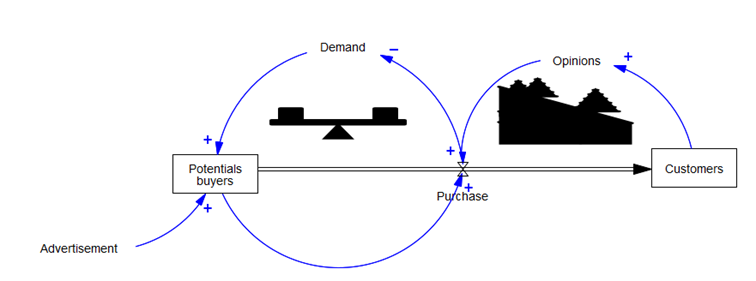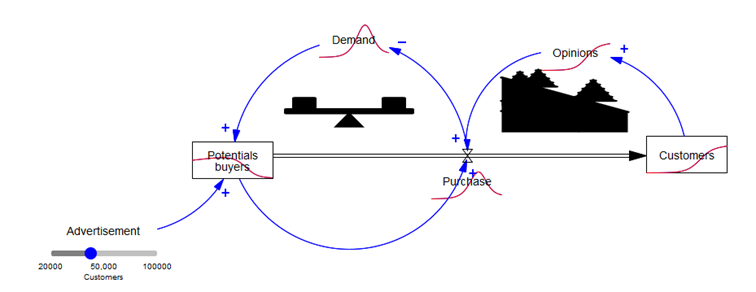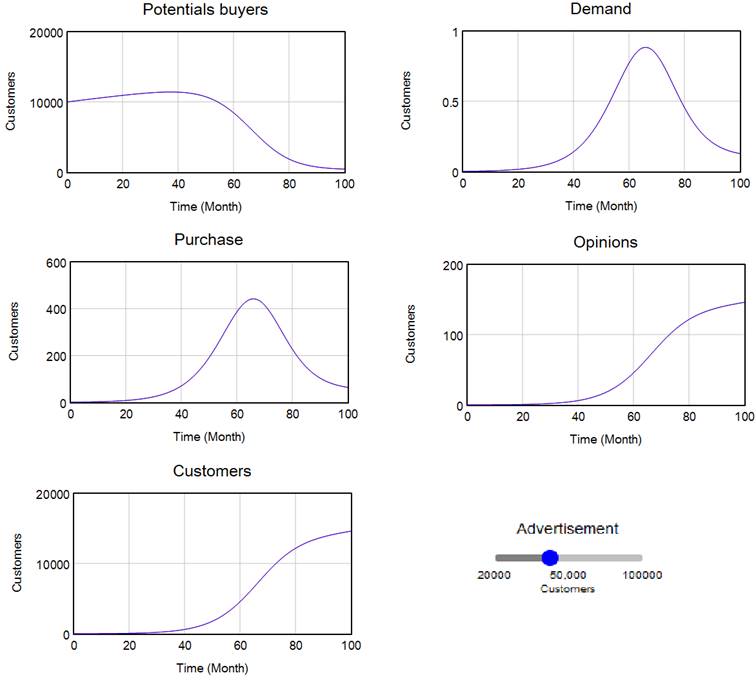Advanced customer acquisition model
1. Introduction
In today’s highly competitive market, businesses must constantly refine their marketing and sales strategies to attract new customers. One of the most effective analytical tools in this regard is dynamic modeling, which allows us to predict the effects of promotional activities and their influence on consumer behavior. This project presents a simplified model of customer acquisition, incorporating the roles of advertising, demand, customer opinions, and purchases.
2. Model Input Data
The model is based on relationships between five main variables:
- Potential buyers: initial number is 10,000.
- Purchase: depends on customer opinions and the number of potential buyers, calculated as:
Purchase = Opinions * 0.001 * Potential buyers - Customers: represent the cumulative purchases, initially 10.
Customers = Purchase - Opinions: generated from the number of customers.
Opinions = Customers * 0.01 - Demand: dependent on the volume of purchases.
Demand = Purchase * 0.002 - Advertisement: fixed value of 50,000.
Potential buyers = Demand - Purchase + (Advertisement * 0.001)
3. Model Analysis Based on Graphs.

Figure 1. Customer acquisition system model.

Figure 2. Model simulation with an advertisement value of 50,000.

Figure 3. Variable trend charts over time
3.1. Model Structure
- Advertising flow: An increase in advertising expenditure leads to an increase in the number of potential buyers.
- Purchase loop: A greater number of potential buyers leads to more purchases.
- Opinion loop: More customers generate more opinions, which further stimulate future purchases.
- Demand loop: A rise in purchases decreases demand, which in turn reduces the number of potential buyers.
3.2. Dynamic Charts
- Potential buyers: This value increases slightly at first, then begins to decline after the 50th month, indicating market saturation.
- Demand: Increases until around the 70th month, then begins to decrease.
- Purchases: Show a strong upward trend between months 40 and 70, then gradually decline.
- Opinions: Grow exponentially, suggesting that customer satisfaction has a strong positive effect on brand reputation.
- Customers: Increase steadily, reaching around 18,000 by the 100th month.
- Advertisement: Fixed at 50,000, it acts as the initial driver of growth across the entire system.
4. Final Conclusions and Summary
The model is designed to illustrate the impact of advertising and the limitations posed by a finite group of potential buyers. It treats them as a closed group that can be expanded through advertising, which stimulates the desire to purchase. The model also shows a gradual decline in the number of potential customers over time, representing market saturation and a decreasing ability to acquire new customers through advertising alone.
The model clearly demonstrates that advertising plays a crucial role in the early stages of customer base growth. It increases the pool of potential buyers, which drives purchases, and these in turn generate customer opinions that stimulate further purchases. However, after a certain point (around the 70th month), the market begins to saturate – the number of potential buyers and overall demand decline, despite the still-growing number of customers and opinions.
Created by Mateusz Kuszpa
